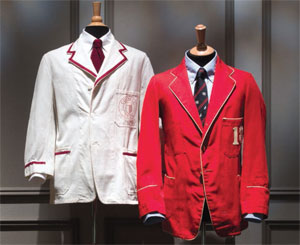Exhibit celebrates the sartorial styles of the Ivy League (yes, even at Cornell)
Exhibit celebrates the sartorial styles of the Ivy League (yes, even at Cornell)
This is one angry bear.
In a museum off Manhattan's Seventh Avenue is a vintage sweatshirt emblazoned with an image of the Big Red Bear smoking a stogie, wearing a sailor's cap and ripped denim overalls. He's got glowing yellow eyes and a hostile expression, and one paw clutches a billy club with a spike sticking out of it. He looks less like a beloved college mascot than a longshoreman on his way to a labor riot.

With its isolated location, land grant roots, and egalitarian bent, Cornell has always been an iconoclast among the Ivies—so maybe it's fitting that one of the University's entries in "Ivy Style," an exhibition of Ivy League fashion, is such a delightful sartorial oddball. The show, which runs through January 5 at the Fashion Institute of Technology, focuses on menswear (since, unlike Cornell, most of the schools were single-sex for much of the twentieth century). It features dozens of outfits—some vintage, others contemporary but traditional, and a few by current designers melding preppy with punk. "One of the interesting things about Ivy style is that we think of it as a static way of dressing—all these classic pieces like polo coats, khakis, oxford button-down shirts," says Jennifer Farley '03, an assistant curator at FIT. "But in its early years it was trendsetting, not a staid way of dressing."
The show—which includes reunion jackets from the classes of 1918 and 1926 on loan from the Cornell Costume and Textile Collection—features such iconic apparel as madras blazers, Bermuda shorts, polo shirts, tweed suits, argyle sweater vests, even a raccoon coat. There are current and/or vintage examples from such purveyors as Brooks Brothers, J. Press, Ralph Lauren, and Tommy Hilfiger—and given their classic lines, it's often hard for the untrained eye to discern the antique from the modern. "It's really English upper-class dress that was emulated by American college students going to elite schools beginning in the nineteenth century," says fiber science and apparel professor Charlotte Jirousek, curator of the Cornell collection. "It's conservative, with high-quality materials and attention to small details in terms of tailoring."
 Princeton, Yale, and Harvard were the primary stylemakers among the Ivies (and are most heavily represented in the FIT exhibit); Cornell was arguably at the other end of the trendsetting spectrum, for reasons that include its coeducational status and its inclusive mission. "Its culture was that everybody could come and get an education as opposed to a relatively elitist separation," Jirousek says. "There was more diversity of dress, more variety." And while classic Ivy looks still abound, she notes that even among self-styled elites, the Sixties upended the idea that clothes denote class. "When you democratize society in the way that this social movement did, clothing also becomes democratized," she says. "So the distinctions between upper- and lower-class dress decidedly changed."
Princeton, Yale, and Harvard were the primary stylemakers among the Ivies (and are most heavily represented in the FIT exhibit); Cornell was arguably at the other end of the trendsetting spectrum, for reasons that include its coeducational status and its inclusive mission. "Its culture was that everybody could come and get an education as opposed to a relatively elitist separation," Jirousek says. "There was more diversity of dress, more variety." And while classic Ivy looks still abound, she notes that even among self-styled elites, the Sixties upended the idea that clothes denote class. "When you democratize society in the way that this social movement did, clothing also becomes democratized," she says. "So the distinctions between upper- and lower-class dress decidedly changed."

That scrappy Big Red Bear sweatshirt, as it turns out, is a product of the Sixties—if barely. It was loaned to the exhibit by Roger Sharp '64, a retired schoolteacher who bought it at the campus store in the fall of 1960. He never actually wore it; he bought it for his girlfriend, a nursing student in Pennsylvania. How did it come back into his possession? Easy, says Sharp: "I married her."
ontemplating downsizing to a smaller house, Sharp—an inveterate packrat—passed the sweatshirt on to his son. "He also wanted my varsity jacket," Sharp says, "but time had taken its toll on it." The fact that his Cornell sweatshirt is on public display has sparked a certain amount of good-natured ribbing. "My son said, 'I hate to tell you this dad,' " Sharp recalls, "'but you're in a museum.'"


